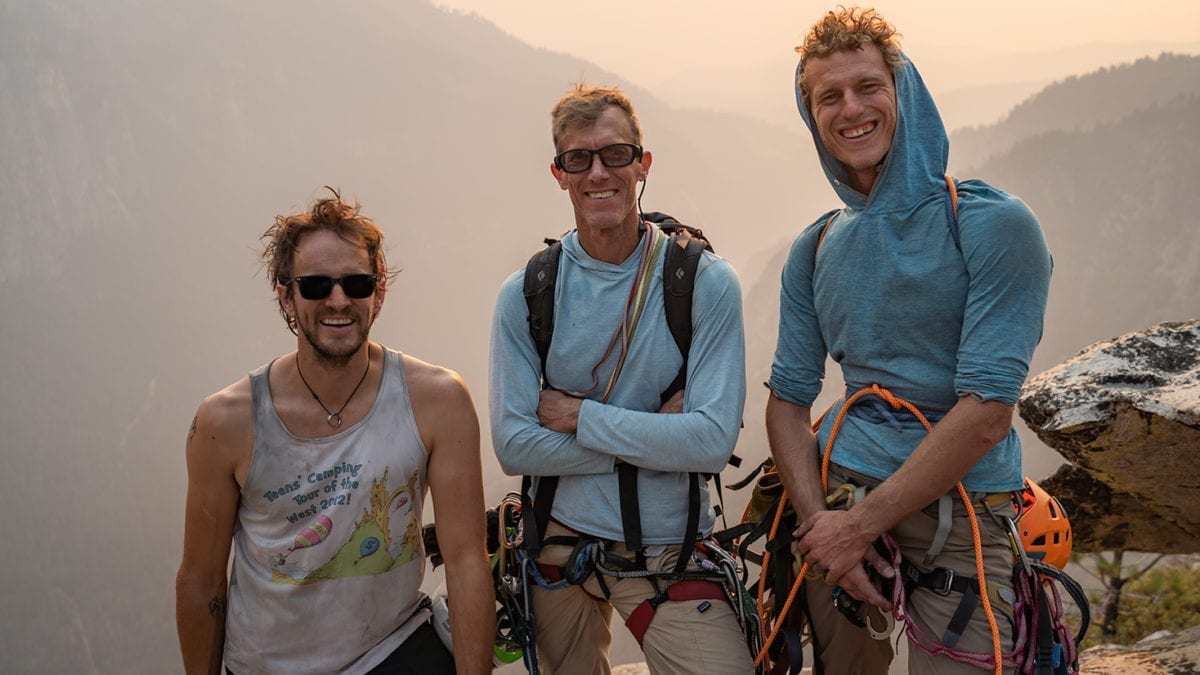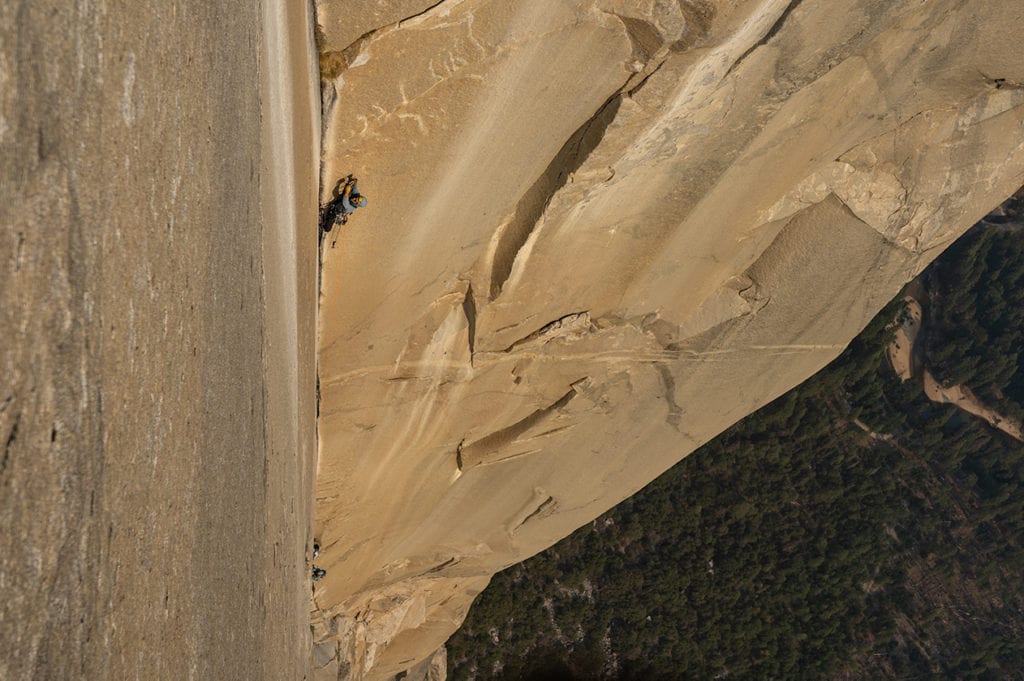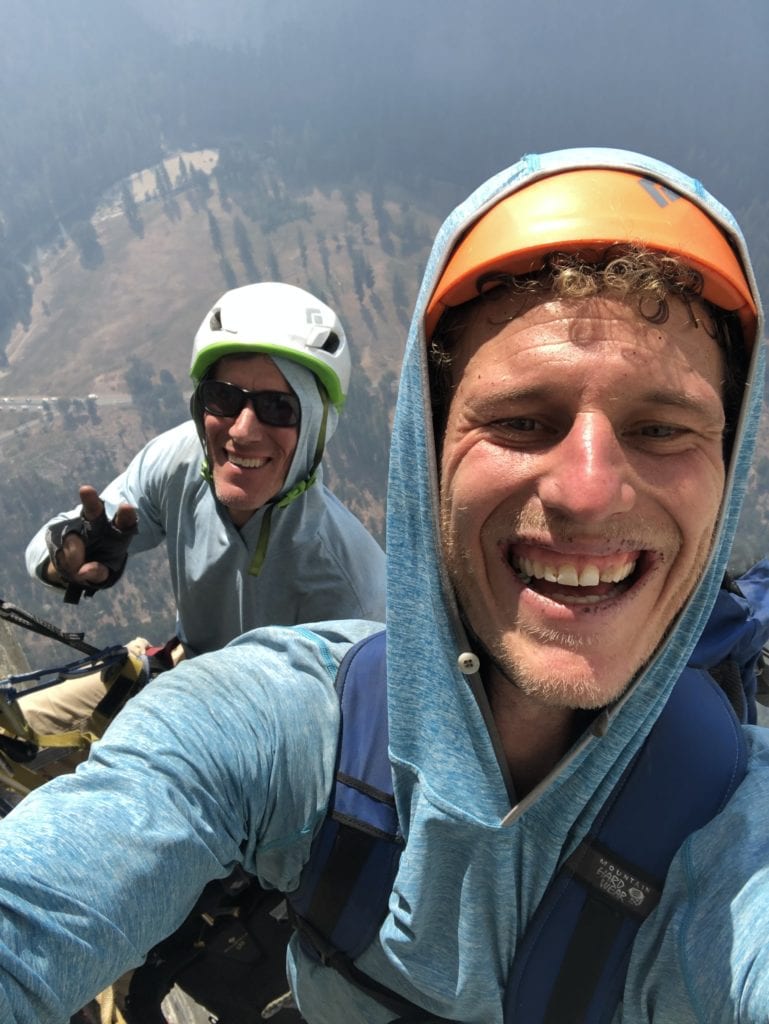Original Muir Wall Route on El Cap Climbed in Record Time
On Oct. 2, Brandon Adams, Tom Herbert and Roger Putnam clocked 12:07 on the historic Muir Wall on El Capitan, shaving 7.5 hours off the record set by Nils Davis and the late Brian McCray in 2001
 Photo by: Max Buschini
Photo by: Max Buschini
Located climber’s left of The Nose and described as “outstanding” and “beautiful” on Mountain Project, and noted as one of El Cap’s “greatest lines” on Alpinist, El Cap’s Muir Wall is 2,900 feet of sustained cracks that require a mix of free and aid climbing.
The Muir Wall was established by TM Herbert (Tom’s dad), and Yvon Chouinard in 1965, making Tom and his partners’ record ascent that much more meaningful.

“It’s this continuous crack system that you can see from across the valley,” Putnam says. “It features thin, clean corner climbing that runs all the way up El Cap. It’s one of the great lines, undisputedly.”
Due to its immense height and thin, technical cracks, the route rarely sees speed ascents. That’s also what makes Adams, Herbert, and Putnam’s ascent noteworthy; their climb of 12:07 is only one of a handful of times the route has gone in sub-24, starting with Hans Florine and Chris McNamara’s 23:29 ascent in 1996, which stood until Brian McCray and Nils Davis did it in 2001 in 19:56. The recent climb shaved 7.5 hours off the record.
Of note, the original Muir line, the one followed by the trio this October, does not go free. Variations of the Muir exist, including the Pre Muir and The Shaft, and some of the upper sections go free as part of the Direct Line, but the entirety of the route has not gone free, and it has aid climbing up to C4 or A2.
Various sources state that the Muir Wall’s record is 12 hours, but that’s misleading as it was done as a free climb and using substantial variations. “Alex Honnold has the Shaft record at 12 hours [belayed by Josh McCoy], we set the Muir Wall record, the original line that my dad climbed with Chouinard,” Tom says.

Roger adds, “The Shaft misses the whole upper corner system; it’s like a 10-pitch variation to the Muir. They’re very different lines for 1,200 feet.”
Instead of relying on sheer boldness to move fast, Adams, Herbert and Putnam chose laughter and lightheartedness, and their years of combined experience to cover 2,900 feet — 33 pitches. Due to nearby wildfires, the trio climbed their route under a haze of hazardous smoke, which turned the sky light orange.
The team started up the wall at 4:45 a.m. “I just remember Brandon and I cranking tunes on the phone and laughing,” Roger says summating the vibe of the climb.
Each team member had previously been on sections of the route, allowing them to move with efficiency during their record climb. Tom had rehearsed the lower third, Roger had climbed the middle third many times during scents of other routes, and Brandon has a skillset that matches the character of the climbing at the top.
They climbed with a double set of Totem cams, Ultralight Camalots, offset cams, assorted pitons, and 15 beaks.
“Totems change the game in a really huge way, as do big beaks, and the ability to use them well and clean them efficiently,” Roger says.
Before their ascent, Herbert spent much of the summer digging dirt out of the cracks on the lower third and improving anchors by installing new bolts. He also established a direct 5.11b start that he climbed with his son Tommy. In the ethos of the Muir Wall and his dad’s affinity for naturalist and conservationist John Muir, he named it after his saying “The Mountains are Calling.”
Climbing with Tom Herbert
In September, I joined Herbert on the lower third of the Muir Wall, the first 1,000 feet known as Muir Blast. Over four hours we climbed A2 terrain via 5.11/A0, where we pulled on cams to get past cruxes up to 5.13 and we used a second rope to lower out through tricky sections. The climbing was sustained laybacking with the left foot on a slab, and right foot jammed in a thin crack. We climbed past original bolts placed by Chouinard and TM Herbert, plus old fixed cams stuck in place for decades. Climbing those pitches was like stepping back in time, where aging gear stuck in-situ out of the cracks: a rigid #1 Friend; a straight taper nut on chord; a rusty RURP; a worn aluminum hanger on an old quarter-inch bolt.
Tom led fast, pausing every so often to plug in a cam or pull-through via short aid moves. He told me he’d been up there many times, often climbing alone via Minitraxioning to dial in the free climbing. Some days he’d climb under smoky conditions and ash rained down the wall from local fires, but he climbed anyway, wearing an N95 mask when necessary. His work paid off. That day with me was his first time leading the pitches mostly free, and he looked like he had it completely dialed.

Last year, partnered with Roger Putnam, Tom celebrated his 50th birthday by lapping El Cap twice in a day. That day, he and Roger blasted up The Nose in 7:21 followed by Lurking Fear in 7:20 a total time of 18:23 including hiking and rappelling between routes.
In addition to his dozens of ascents of El Cap — separately he’s climbed the big wall with his dad and his son — Tom is a 5.14 climber and 5.14 first ascentionist. “I knew I would never climb big walls like my dad,” he says. “So I pursued sport climbing. I left my mark in a different way. My dad’s shoes were too big to fill.”
Tom’s first memories are from playing in the dirt in Camp 4 while surrounded by the Golden Age greats: Royal Robbins, Tom Frost, Yvon Chouinard. During summers Tom lived in the climbing guide’s housing area in Tuolumne Meadows. Tom is a former climbing guide himself. Today he works as a hospitalist physician, and he splits his time between his homes in Reno, Nevada and Yosemite West, California.
Tom graces the cover of the 1990s Tuolumne Free Climbs guidebook, where he’s seen crimping up the 5.13c Rising Sun on Pywiack Dome.
He adds, “Now that I’m older, I’m excited about the big stuff.”
Roger Putnam
Known as “The Animal” to his big wall climbing friends, Roger is a frequent partner of Brandon Adams and together the two have set many records in Yosemite. Roger lives in Moorpark, California where he works as a professor of Geology at Moorpark College. He’s also a co-author of Yosemite Bigwalls. Additionally, as part of his graduate work, he completed the first geologic map of El Capitan.
Putnam moved to Yosemite in 2006 where he worked as a restoration ecologist for the park service until 2011, removing unsustainable campsites and invasive plants and doing geographic information systems (GIS) analyses in support of restoration efforts. Following his time in Yosemite, Roger earned a Masters Degree in geology from UNC Chapel Hill, North Carolina after which he moved to Sonora, Calif.
The Muir Wall marks Roger’s sixth El Cap speed record (Mescalito in 13:56, Shield in 8:55, Waterfall Route in 6:29, Flight of the Albatross in 9:32, Grape Race 8:21). To date, he’s done 19 different routes and 64 total ascents.
Roger says of Brandon and his climbing partnership, “I can do simple free climbing and simple aid quickly, and I can follow quickly. And he can do tricky aid quickly.”
Brandon Adams
“[Brandon is] unquestionably the best aid climber of our generation,” Roger wrote in Rock and Ice.
When I interviewed him in October 2019 for Climbing, Brandon told me he’d completed 21 different routes via 37 times. When we talked this October he said his tally is up 29 routes and 48 total ascents. He holds nine speed records on the Big Stone. In 2018 he left his mark on El Capitan with a hard-aid first ascent, completed with Kristoffer Wickstrom, called Ephemeron, requiring 10 days on the wall. Because of the heavy use of beaks on the continuous A4 pitches, I titled the story “Beaks for Days.”
Brandon works as a climbing ranger in Yosemite, where he patrols the vertical wilderness. Half the year he lives inside the park gates and the other half of the year he lives in Bishop, California.
What Makes the Muir Wall Historic?
When TM Herbert and Yvon Chouinard climbed the first ascent of the Muir Wall over eight days in 1965, they became the first party to climb a first ascent of an El Cap route in a team of two and in a single push. Their ascent pushed themselves and their gear to the edge. Chouinard wrote in the 1966 American Alpine Journal:
The climbing continued to be extreme and in our now very weakened state strenuous pitches took us hours to lead. TM is normally a fairly conservative climber, but now he was climbing brilliantly. He attacked the most difficult pitch of the climb, an overhanging series of loose flakes, with absolute confidence; he placed pitons behind the gigantic loose blocks that could break off at any moment, never hesitating and never doubting his ability.
Awakening on the eighth day, we promptly devoured the last few bites of food and the last of our water. Four bolts were left; 400 feet to go, and always that summit overhang weighing on our minds. It was going to be close.
With Chouinard and Herbert’s two-person ascent of El Cap done, there was only one option left to progress the style, to climb solo. That’s what prompted Royal Robbins to do the route by himself in 1968.
Over ten days, Robbins soloed the Muir Wall, once taking a fall on the route and having a RURP catch him. Unable to proceed through that section after his fall, Robbins drilled a bolt. The RURP that held him is on display at the Yosemite Climbing Museum in Mariposa, California (opening November 1).
Of his aid solo ascent, Robbins wrote:
El Capitan had not been soloed. I had not climbed the John Muir Route. It was the obvious choice. And this would be the second ascent, which would give me something to gloat over, if I were inclined to gloat, which I am, secretly. The story of the epic first ascent by TM Herbert and Yvon Chouinard has been well told in the A.A.J., 1966. But Chouinard’s enthralling account was a bit sparse in details, and I was to regret this in the days ahead….
This was no fun-in-the-sun rock climb.

Kind Words from Liz Robbins
With Robbins’ passing in 2017, his climbs are now forever in the annals of climbing lore. And though he experienced many adventures in his lifetime, his climb of the Muir Wall in 1968 remained a special adventure for him. It had such an impression that he spoke of it to his wife Liz Robbins.
Yesterday morning, Liz sent Tom this message congratulating him and his team:
“Royal would be (is) happy to hear this news,” she said.
Photographer and filmmaker Max Buschini — director of Peter and the Columns — captured the team’s record-breaking ascent on video and is now in the works of making a short film. Be on the lookout for it in the coming weeks.


